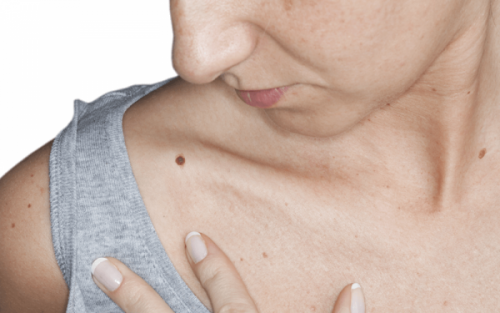In most cases, moles are harmless spots that can appear at any age, on any part of your body. They come in a wide range of colors, shapes, and sizes. But in certain circumstances, moles should be examined by a dermatologist, and mole removal may be necessary. How do you know if your moles are “normal”? And if they’re not normal, when should you visit your doctor?
Normal vs. Atypical Moles
“Normal” moles are typically smaller than a pencil eraser, round and symmetrical with an even color and smooth borders. They are often tan or pink, and though you may not like them cosmetically, there is no medical reason to have them removed.
Atypical moles — also called dysplastic nevi — are unusual looking moles that are non-cancerous. When viewed at the cellular level, these moles look different than healthy, normal moles. They may be asymmetric, very dark or multi-colored and may have indistinct borders. Often found on the back, chest, buttocks or scalp, these moles look different than the other moles on your body.
Atypical moles may look like melanoma — the deadliest form of skin cancer — but don’t worry, they’re not cancerous. Atypical moles won’t necessarily develop into skin cancer, but if you have 10 or more dysplastic nevi moles, you do have a higher risk of developing melanoma (roughly 12 times the risk of the general population). Melanoma can spread very quickly but is curable if caught early.
Before Surgery
Suspicious or abnormal moles should be checked out by a dermatologist. Sometimes, your doctor will suggest that you monitor these moles regularly to detect any changes. Other times, surgical mole removal is needed.
Some atypical moles (dysplastic nevi) may change into melanoma, but most of them will never become cancerous. In fact, melanoma is more like to develop from normal skin than from pre-existing moles. Nevertheless, people with many atypical moles may be at greater risk for melanoma. Under the microscope, atypical moles can be graded as mild, moderate, or severe based on their unusual features. Most of the time, if the atypical moles are only mildly or moderately dysplastic, no further treatment is needed. However, if the atypical moles that are severely dysplastic, surgical removal with a margin is recommended to ensure no features of melanoma are present.
“The main reason that severely dysplastic nevi need to be surgically excised is not because they confer a higher risk to develop into melanoma, but rather the possibility of them representing misdiagnosed melanoma in-situ,” says Dr. Leon Chen, a board-certified dermatologist and Mohs surgeon at U.S. Dermatology Houston Medical District. “If you have moles that look suspicious, it’s a good idea to take pictures of them as a reference, so you can determine whether they are changing.”
Extreme changes in the size, border, or color of any mole can be an indication that it has a high potential to develop into melanoma. In this case, a biopsy of the mole is needed to establish a diagnosis.
You should have regular evaluations of your skin by a board-certified dermatologist every six to 12 months, but you should also make it a habit to monitor your moles at home.
If you notice that you have a new mole (especially after the age of 40) or that an existing mole has changed in color or grown, you should have it evaluated by a professional. Check every part of your skin, even between your toes and on the bottoms of your feet, on a regular basis. Ask someone you trust to check the areas of your body that are difficult to see.
And always, remember to wear sunscreen! Damaging UV rays can cause atypical changes in moles.
Mole Removal Options
There are several available treatments for mole removal. In some cases, moles require surgical excision. Your dermatologist will cut out the entire mole with a margin and stitch the skin back together. Other times, your doctor may use a surgical blade to shave off the mole. In both cases, the removed mole tissue will be examined under a microscope to determine if cancer cells are present.
Ultimately, whether or not you should have a mole removed depends on several factors. If you have many atypical moles, removing all of them may not be the best solution. If, on the other hand, you have just a few atypical moles, combined with a family history of melanoma, complete surgical removal of all your atypical moles might be the right decision.
Looking to Visit a Dermatologist for Mole Removal?
Contact U.S. Dermatology today to consult with a board-certified dermatologist about a full skin examination and mole treatment plan that is right for you. We have multiple locations throughout the country, so fill out our simple online form to get in touch with us. One of our local team members will reach out to you shortly to answer your questions or schedule an appointment for you to visit us soon.
Find a location near me
or


